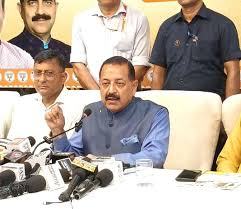Govt has not abandoned lateral entry to posts, says MoS Jitendra Singh months after UPSC cancelled ad following backlash

Union Minister of State for Personnel, Jitendra Singh, has clarified that the lateral entry scheme for civil service roles is still active. His statement comes months after UPSC withdrew its advertisement for lateral recruitment, which triggered widespread criticism over the absence of reservation provisions.
What Is the Lateral Entry Scheme?
Lateral entry allows professionals outside the traditional civil services to apply for high-level posts in the government. These include Joint Secretary, Director, and Deputy Secretary roles. The idea is to bring in experienced specialists who can contribute fresh ideas and domain expertise to public administration.
Conventional recruitment promotes officers within the system. However, critics believe this approach often lacks technical or field-specific skills. Lateral entry, therefore, was proposed as a corrective measure to strengthen policy-making with expert input.
The Controversy Over the UPSC Advertisement
In August 2024, UPSC released an advertisement for 45 lateral entry positions. Almost immediately, several political parties and civil rights organizations raised objections. Their main concern was the lack of reservation for SC, ST, OBC, and other marginalized groups.
The backlash grew quickly. Even parties aligned with the ruling NDA, such as the Lok Janshakti Party, demanded withdrawal of the ad. On August 20, the government asked UPSC to cancel it. Many assumed this signaled the end of the lateral entry policy.
Minister Jitendra Singh Clarifies Government’s Stand
On June 18, 2025, Minister Jitendra Singh addressed the issue. He said the government has not dropped the lateral entry initiative. According to him, the advertisement was withdrawn to reconsider its alignment with constitutional norms, not to end the policy.
“Lateral entry remains a vital part of our governance reforms. We aim to bring in skilled professionals from various fields to enhance efficiency,” Singh said.
He stressed that the program is not being abandoned but is under review to make it more inclusive.
Addressing the Reservation Challenge
The lack of reservations in lateral entry roles is the core issue. Since most of these are single-post vacancies, the current system does not mandate reservation. Critics argue this leads to exclusion of underrepresented communities.
Singh acknowledged these concerns. He confirmed that the Department of Personnel and Training (DoPT) is examining ways to incorporate reservation while preserving the merit-based structure of lateral entry. This includes creating post pools or batches where reservation can be applied without legal or logistical issues.
“We are committed to social equity as well as administrative reform,” Singh said.
A Revised Framework Under Consideration
Government officials have hinted at ongoing efforts to redesign the lateral entry model. One idea involves grouping roles into categories where reservation rules can be applied more easily. Another suggestion is to earmark some lateral posts specifically for reserved categories.
These proposals come with practical challenges. Lateral candidates come from diverse fields and may not fit into uniform qualification criteria. The government needs a system that ensures fairness while not compromising on professional standards.
Despite the complications, the government appears determined to find a workable solution. Singh emphasized that inclusion and efficiency can go hand-in-hand if implemented thoughtfully.
Political Impact of the Controversy
The UPSC ad controversy highlights how politically sensitive reservation remains. Any policy seen as undermining social justice can provoke strong responses from allies and opponents alike. As India approaches major elections, this issue could influence political narratives.
The government’s attempt to balance expertise and equity reflects a broader struggle in policymaking. Reforming the bureaucracy is necessary, but doing so without alienating marginalized communities is just as critical.
Conclusion
The government’s decision to continue the lateral entry scheme—while considering mechanisms to include reservation—shows its intent to modernize the bureaucracy. At the same time, it recognizes the importance of maintaining representation and fairness.
By reaffirming its commitment, the government has sent a clear message: it wants to reform civil services, but not at the cost of constitutional values. Whether it can develop a fair and effective lateral recruitment framework remains to be seen, but the conversation is clearly not over.






